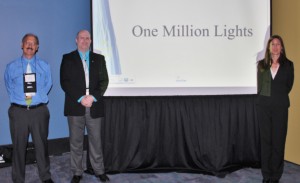One Million Lights and www.philanthropic-engineering.org is getting lots of attention. BETT’15, INTED’15, CIO Congress’15, Education Congress’15 and now NSTA’15.
There are three things in this blog. #1. The idea of One Million Lights and Philanthropic-engineering seems to be getting international traction. #2. Collaboration is much harder than Cooperation, but gives such a better final product AND is a great growing experience. #3. Maybe 1 Million Lights will be distributed, changing both the students who receive them, and the students who make them. #4. People want cookie cutter.
#1. “What School could be” gaining International Traction:
Educators around the world know that school seems to be broken. There is lots of theory and vision of what they would like school to be, but have few clear practical examples. One Million Lights seems to be one emerging example. International students from Y4 UK, to US Middle School to Canadian High School, working truly collaboratively, where there are multiple iterations and minds are changed in the process. STEM topics are blended with CAD, world issues, geography, and literacy. Perhaps this could hint towards what school should and could be? www.philanthropic-engineering.org
#2.Challenging but better, Collaboration vs Cooperation:
My Colorado friends, Tracey and John, spoke about One Million Lights at INTED’15 in Madrid while simultaneously, I spoke about the same thing at CIO Congress and Education Congress in Palm Springs.
Now we need to present the same work together. It would have been much easier just to say that one group does their part while the other group does the other part and paste them together. It started out a synchronously with Tracey doing the lion’s share. I was able to add some slides and change some content. This was great COOPERATION. However, to work collaboratively, we needed to work on the same slides.
So, the day before, we spent all afternoon with the three of us going over slide by slide. Matching three different styles together with a deadline was fun, but could have been frustrating had we not gelled so well. There was moving, moving back, trying this and trying that. In the end we had something that worked well.
On the day of the presentation, we still had not practiced it the whole way though. We assigned various slides to various speakers, discussed the content, but did not actually practice.
There we were on stage. We had 1hr. We took 54 min. There were a couple of times that I did not quite finish correctly, and the other would step in, say what I missed and use it as a transition to the next slide. It worked so well, it was like it was practiced, but it was not.
Not only did we have more perspectives represented in the talk, but we would never had been able to cover for each other and move fluidly had we only cooperated. Thank goodness we collaborated.
One Million Lights’ goal of One Million Lights distributed around the world may be possible.
During the previous day, in the same room at a similar time, there was 1-4 people in the audience. For us, we had 38 people, a virtual crowd given the location and timing.
The audience was engaged, nodding in agreement, positive body language and lots of questions afterwards. We had 6 people come up afterwards and have some deeper conversations. The invitation was well received. I think we will get some people on board.
We better be ready for it.
#4 Cookie Cutter Programs
We are surrounded by 1001 programs, curriculums and guides that offer step by step instructions. It was ironic how one of the teacher questions compared to one of Tracey’s stories during the presentation.
We created this with the idea that students should be involved with thinking and doing and creating. Tracey gave the example of how grit, perseverance and thinking were products of PRODUCTIVE FRUSTRATION. When a student did not know where to solder the next LED, the student wanted the teacher to say, “good job, now do the next one there”. This is how the student had been trained over 7 years of school. The teacher had to resist celebrating and then telling. Had the teacher told them what to do, the product (the light) would have been done faster and more efficient, but the student would not have learned to think, to try, to demonstrate grit. There was an audible sigh of agreement from the crowd when this was discussed.
At the end of the talk, one of the questions asked if there were published lesson plans, curriculum guides and rubrics. The irony between what we were trying to teach the students and what the teacher was asking made me feel like re-writing a verse to an Alanis Morisette song. We want teachers and students to have a personal connection to the work. We want teachers to model the same creativity, diversity and grit that we expect from our students. Even the teachers have been programmed to be little robots.
Ideally, all teachers would pick this program up and run with it, like Preston, RHS and Pheasey. However, the reality is that not all are risk takers. In fact, I suspect the risk takers are already doing their own cool thing. In order to move teachers and students towards a favorable side of the spectrum, we may need to provide help. How much is the right amount of help so that people will be encouraged to participate, but maintain the critical thinking, creativity and ownership?


